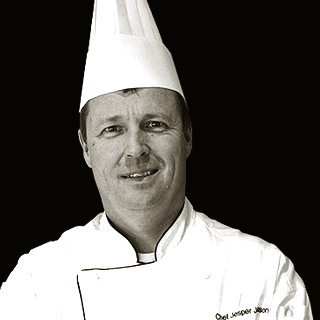Listen to This Article:
Are you ready to take your cooking skills to the next level? If you want to set yourself apart from others in the competitive culinary industry, it may be time to move past the culinary basics. With a solid foundation in place, advanced cooking techniques can provide a way to incorporate precision, depth, and creativity into your dishes.
Here’s a look at five professional cooking techniques that can help you transform your approach in the kitchen and inspire new culinary possibilities.
1. Anti-Griddle and Liquid Nitrogen – For Flash Freezing
Almost every chef is familiar with the griddle – the flat metal surface that generates even, controlled heat. As a chef, you likely turn to the griddle to saute onions, churn out stacks of pancakes, and cook burgers.
However, you may not be familiar with the griddle’s cold cousin, the anti-griddle. This device pumps refrigerant to generate an extremely cold surface – as low as -30 degrees Fahrenheit. This cold surface flash freezes sauces, foams, and purees into a solid or semi-solid state. In less than 90 seconds, the anti-griddle can transform liquids into morsels with crunchy outer shells and cool, creamy centers.
Often used in molecular gastronomy, the anti-griddle was dreamt up by the team at the famous Chicago restaurant Alinea. They collaborated with innovators at PolyScience to create this new piece of cooking equipment.
Even if you don’t have access to an anti-griddle, you can still experiment with flash-freezing by using liquid nitrogen. With a temperature of -320 degrees Fahrenheit, this material quickly freezes food and reduces water content, allowing chefs to create powdered oils and frozen foams.
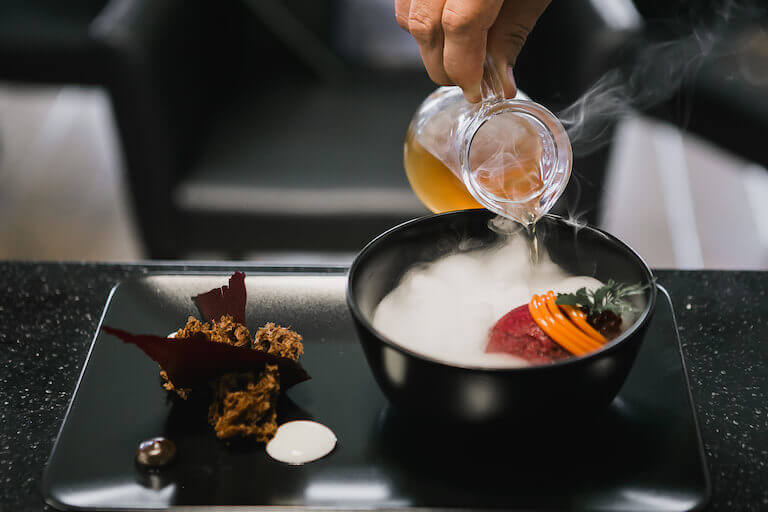
Using tools like the anti-griddle, chefs can experiment with flash-freezing techniques to create unique textures, transforming sauces and foams into frozen, flavorful bites with a crisp exterior and creamy interior.
2. Chaunk – For Fragrant Spices
While whole spices like cumin seeds and cardamom pods bring warming flavors to any dish, heating these spices in a pan takes their aroma to a whole new level. Blooming spices over dry heat is a common technique in kitchens, but this isn’t the only way to bring out flavors.
*Information may not reflect every student’s experience. Results and outcomes may be based on several factors, such as geographical region or previous experience.
Another way to achieve a similar effect is to fry those spices in a hot fat, like oil or ghee. Blooming spices in fat is called chaunk. Also referred to as baghar or tadka, this cooking method originated in India and parts of the Middle East.
Different regions have their own preferred fat sources and combinations of spices. Cumin, mustard seeds, coriander, fennel, turmeric, and cinnamon are common, along with fresh aromatics like onion, ginger, chiles, and garlic.
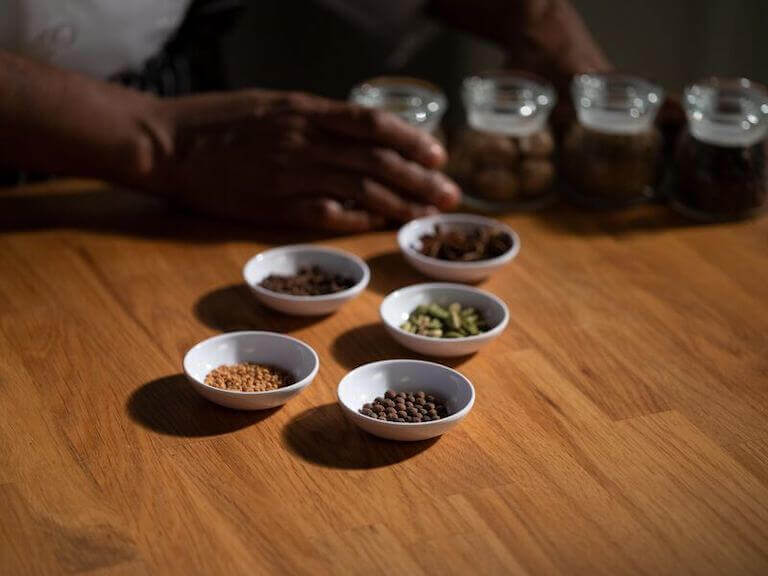
Whole spices like cumin, cardamom, and mustard seeds are key ingredients in techniques like chaunk, where blooming spices in hot oil releases deep, aromatic flavors into a dish.
Making chaunk is a straightforward process, but mastering the balance of flavors requires a bit of experience and practice. For example, a flavorful oil like coconut may work well for a chaunk served alongside a chutney. But it might compete with the flavors of saag paneer — a spinach and cheese dish.
Auguste Escoffier School of Culinary Arts students explore the balance of taste, aroma, and texture as part of their curriculum. This focus on the flavor profile helps them to see a dish as a whole, so they can anticipate how the chaunk will impact the final product.
Students can also explore techniques and global flavors in the World Cuisines course, which takes them on a culinary “road trip” through the food traditions and flavors of Europe, Asia, the Middle East, and the Americas.
3. Engastration – For Creative Layering
If you have heard of turducken, or a turkey stuffed with a duck stuffed with a chicken, you’re already familiar with the one modern form of this cooking method. Yet this technique of treating food like nesting dolls, officially called engastration, has existed for hundreds of years, all the way back to the Middle Ages. Another savory engastration creation is Pandora’s cushion – a goose stuffed with a chicken stuffed with a quail – which was popular in the 19th century.
On the sweet side is the Cherpumple, which contains three pies (cherry, pumpkin, and apple), all stacked and cooked inside a cake. In recent years, pastry chefs have taken creative liberty with this idea and stacked all types of pies inside cakes. Their name for this type of engastration? A PieCaken!
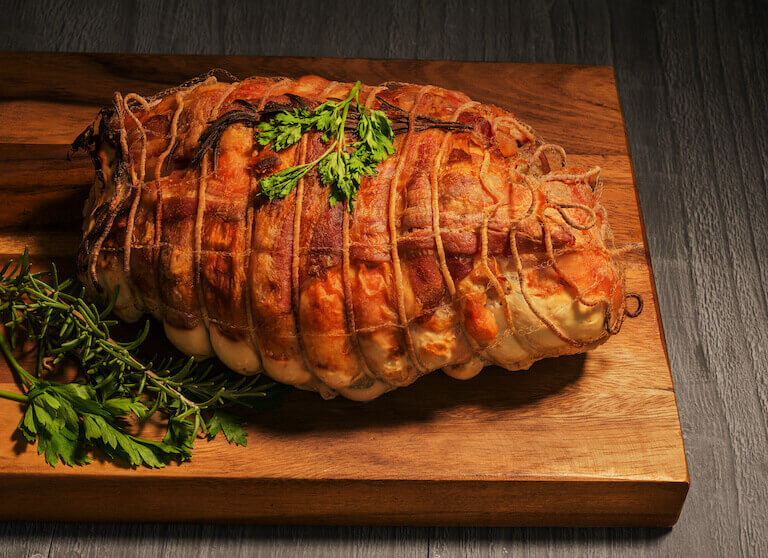
Engastration, the technique of nesting one ingredient inside another, creates impressive, multi-layered dishes like the turducken—a combination of turkey, duck, and chicken roasted together for a flavorful experience.
Engastration undeniably leads to impressive entrees and desserts, but it can be complicated. These creations can take several days to complete since chefs need to cook the individual parts separately. They must also be extra careful to ensure that each component is cooked to a safe temperature before eating.
Before playing with engastration, chefs should have a thorough understanding of food safety. At Escoffier, culinary arts students start their programs with Culinary Foundations, which covers basic techniques like food safety and sanitation.
4. Sous Vide – For Tender and Evenly Cooked Meals
Although the French term sous vide translates to under vacuum in English, this literal meaning explains part of this cooking technique. The entire method involves tightly sealing meat, vegetables, or other ingredients in a plastic bag and then slowly cooking them in a pot of simmering water.
By keeping the water at a stable temperature throughout the entire cooking process, chefs are able to achieve supremely tender pork chops and evenly- cooked chicken breasts.
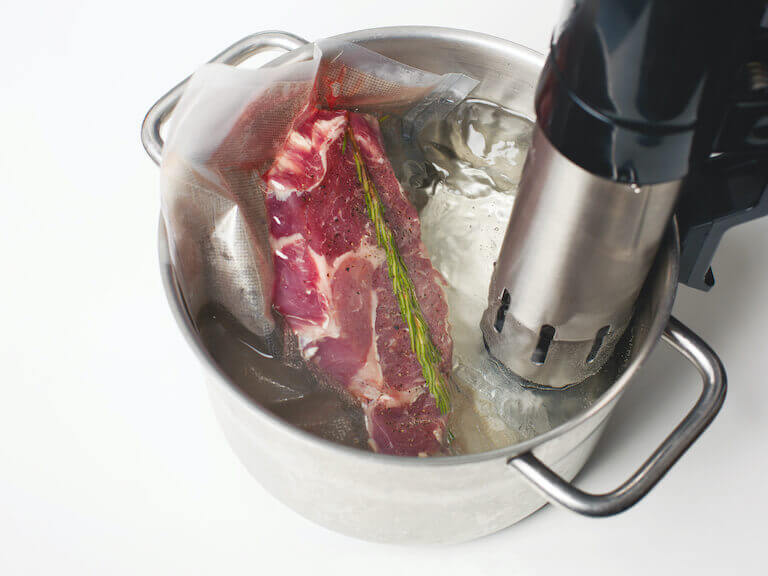
Sous vide cooking allows chefs to achieve tender, evenly cooked dishes by sealing ingredients in a bag and immersing them in a precisely controlled water bath.
Another benefit of sous vide cooking is the lack of guesswork regarding cook time. While roasting, grilling, or sautéing typically involves checking meat with a thermometer or piercing potatoes with a fork, the sous vide method allows chefs to obtain perfectly-cooked ingredients without any poking or prodding.
To maintain the crucial stable water temperature, chefs typically rely on a specific tool called an immersion circulator. This tool draws in water, heats it up, and spits it back out, leading to a stable temperature. Another useful – but not completely necessary – tool is a vacuum sealer. While a hand-sealed airtight bag can do the trick, a vacuum-sealed bag can take sous vide cooking to the next level.
5. Flambé – For Dramatic Flavor and Presentation
Flambé is an advanced cooking technique that adds rich, concentrated flavors to a dish. You add alcohol to a hot pan and then ignite it to burn off the alcohol with a quick burst of flames. It makes for an impressive presentation while adding depth to the dish by combining ingredients together to create a memorable taste in both sweet and savory dishes.
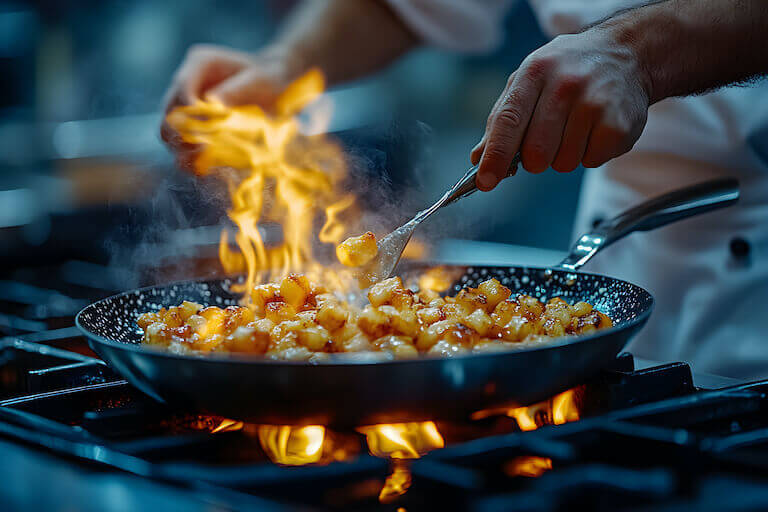
Flambéing creates an impressive presentation while deepening the flavors in a dish.
Flambé is a professional cooking technique used in dishes like Bananas Foster, Steak Diane, and Crêpes Suzette.
To flambé safely:
- Choose the Right Alcohol: High-proof spirits like brandy, rum, or whiskey work well due to their alcohol content, which is essential for ignition. For safety reasons, you’ll want to avoid using alcohol above 120 proof.
- Warm the Alcohol (Optional): Warming the alcohol before adding it to the pan can help it ignite more easily. However, this is not necessary. Just remember, never pour directly from the bottle into the pan, as this can lead to a dangerous flare-up.
- Ignite Safely: Use a long lighter to ignite the alcohol from a safe distance, and be ready to move your hand away quickly. Always keep a lid nearby in case you need to extinguish the flames.
- Experiment with Variations: For added aroma, toss a few herbs like rosemary or thyme into the pan before igniting the alcohol. This not only enhances flavor but adds a subtle fragrance to the dish.
Remember to always flambé in a well-ventilated area since there will be an open flame. Tie loose clothing and hair back, and avoid using non-heatproof pans.
First, Tackle the Culinary Basics
Before you can tackle advanced cooking techniques, it’s important to become proficient in the basics.
Culinary school can provide you with a solid understanding of these fundamentals and help introduce you to talented mentors and a newfound sense of culinary confidence. Contact us today to learn more about our programs.
LOOKING FOR MORE PROFESSIONAL COOKING TECHNIQUES?
- What Is Mise en Place and Why Is It So Important to Chefs
- The Art of Food Presentation
- Correcting Some Common Kitchen Disasters
This article was originally published on December 28, 2015, and has since been updated.
*Information may not reflect every student’s experience. Results and outcomes may be based on several factors, such as geographical region or previous experience.

